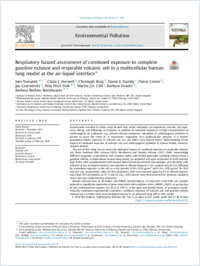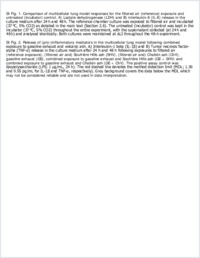Respiratory hazard assessment of combined exposure to complete gasoline exhaust and respirable volcanic ash in a multicellular human lung model at the air-liquid interface
- Tomašek, Ines BioNanomaterials group, Adolphe Merkle Institute, University of Fribourg, Switzerland
- Horwell, Claire J. Institute of Hazard, Risk & Resilience, Department of Earth Sciences, Durham University, Science Labs, Durham, DH1 3LE, United Kingdom
- Bisig, Christoph BioNanomaterials group, Adolphe Merkle Institute, University of Fribourg, Switzerland
- Damby, David E. Volcano Science Center, United States Geological Survey, Menlo Park, CA, United States
- Comte, Pierre Laboratory for IC-Engines and Exhaust Emission Control, Bern University for Applied Sciences, Nidau, Switzerland
- Czerwinski, Jan Laboratory for IC-Engines and Exhaust Emission Control, Bern University for Applied Sciences, Nidau, Switzerland
- Petri-Fink, Alke Chemistry Department, University of Fribourg, Switzerland
- Clift, Martin J. D. In Vitro Toxicology Group, Swansea University Medical School, Singleton Park Campus, Swansea, Wales, United Kingdom
- Drasler, Barbara BioNanomaterials group, Adolphe Merkle Institute, University of Fribourg, Switzerland
- Rothen-Rutishauser, Barbara BioNanomaterials group, Adolphe Merkle Institute, University of Fribourg, Switzerland
-
01.07.2018
Published in:
- Environmental Pollution. - 2018, vol. 238, p. 977–987
English
Communities resident in urban areas located near active volcanoes can experience volcanic ash exposures during, and following, an eruption, in addition to sustained exposures to high concentrations of anthropogenic air pollutants (e.g., vehicle exhaust emissions). Inhalation of anthropogenic pollution is known to cause the onset of, or exacerbate, respiratory and cardiovascular diseases. It is further postulated similar exposure to volcanic ash can also affect such disease states. Understanding of the impact of combined exposure of volcanic ash and anthropogenic pollution to human health, however, remains limited. The aim of this study was to assess the biological impact of combined exposure to respirable volcanic ash (from Soufrière Hills volcano (SHV), Montserrat and Chaitén volcano (ChV), Chile; representing different magmatic compositions and eruption styles) and freshly-generated complete exhaust from a gasoline vehicle. A multicellular human lung model (an epithelial cell-layer composed of A549 alveolar type II-like cells complemented with human blood monocyte-derived macrophages and dendritic cells cultured at the air-liquid interface) was exposed to diluted exhaust (1:10) continuously for 6 h, followed by immediate exposure to the ash as a dry powder (0.54 ± 0.19 μg/cm2 and 0.39 ± 0.09 μg/cm2 for SHV and ChV ash, respectively). After an 18 h incubation, cells were exposed again for 6 h to diluted exhaust, and a final 18 h incubation (at 37 °C and 5% CO2). Cell cultures were then assessed for cytotoxic, oxidative stress and (pro-)inflammatory responses. Results indicate that, at all tested (sub-lethal) concentrations, co-exposures with both ash samples induced no significant expression of genes associated with oxidative stress (HMOX1, NQO1) or production of (pro-)inflammatory markers (IL-1β, IL-8, TNF-α) at the gene and protein levels. In summary, considering the employed experimental conditions, combined exposure of volcanic ash and gasoline vehicle exhaust has a limited short-term biological impact to an advanced lung cell in vitro model.
- Faculty
- Faculté des sciences et de médecine
- Department
- Département de Chimie
- Language
-
- English
- Classification
- Chemistry
- License
- License undefined
- Identifiers
-
- RERO DOC 309462
- DOI 10.1016/j.envpol.2018.01.115
- Persistent URL
- https://folia.unifr.ch/unifr/documents/307096
Other files
Statistics
Document views: 66
File downloads:
- fin_rha.pdf: 115
- fin_rha_sm.pdf: 75

